This article is currently in the process of being translated into Korean (~10% done).
Using WPF styles
이전 챕터에서, 우리는 컨트롤의 특정 타입(TextBlock)을 타깃으로 하는 지역적으로만 정의된 style의 매우 기본적인 예제만 사용하여 styles의 기본 컨셉에 대해 소개했습니다. 하지만 styles는 당신이 그들을 어떻게 어디에 사용하는지에 따라 여러 다른 범위에 정의가 될 수 있으며 당신은 또한 당신이 명시적으로 원하는 컨트롤들에만 styles를 제한 할 수 있습니다. 이 챕터에서는 당신에게 style이 정의될 수 있는 여러가지 방법에 대해 보여드리고자 합니다.
Local control specific style
사실, 아래 예제처럼 스타일을 컨트롤에 직접 정의할 수 있습니다.
<Window x:Class="WpfTutorialSamples.Styles.ControlSpecificStyleSample"
xmlns="http://schemas.microsoft.com/winfx/2006/xaml/presentation"
xmlns:x="http://schemas.microsoft.com/winfx/2006/xaml"
Title="ControlSpecificStyleSample" Height="100" Width="300">
<Grid Margin="10">
<TextBlock Text="Style test">
<TextBlock.Style>
<Style>
<Setter Property="TextBlock.FontSize" Value="36" />
</Style>
</TextBlock.Style>
</TextBlock>
</Grid>
</Window>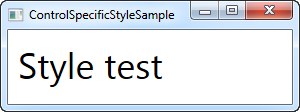
In this example, the style only affects this specific TextBlock control, so why bother? Well, in this case, it makes no sense at all. I could have replaced all that extra markup with a single FontSize property on the TextBlock control, but as we'll see later, styles can do a bit more than just set properties, for instance, style triggers could make the above example useful in a real life application. However, most of the styles you'll define will likely be in a higher scope.
Local child control style
Using the Resources section of a control, you can target child controls of this control (and child controls of those child controls and so on). This is basically what we did in the introduction example in the last chapter, which looked like this:
<Window x:Class="WpfTutorialSamples.Styles.SimpleStyleSample"
xmlns="http://schemas.microsoft.com/winfx/2006/xaml/presentation"
xmlns:x="http://schemas.microsoft.com/winfx/2006/xaml"
Title="SimpleStyleSample" Height="200" Width="250">
<StackPanel Margin="10">
<StackPanel.Resources>
<Style TargetType="TextBlock">
<Setter Property="Foreground" Value="Gray" />
<Setter Property="FontSize" Value="24" />
</Style>
</StackPanel.Resources>
<TextBlock>Header 1</TextBlock>
<TextBlock>Header 2</TextBlock>
<TextBlock Foreground="Blue">Header 3</TextBlock>
</StackPanel>
</Window>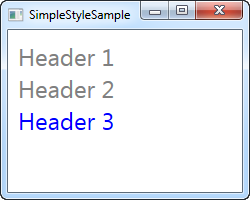
This is great for the more local styling needs. For instance, it would make perfect sense to do this in a dialog where you simply needed a set of controls to look the same, instead of setting the individual properties on each of them.
Window-wide styles
The next step up in the scope hierarchy is to define the style(s) within the Window resources. This is done in exactly the same way as above for the StackPanel, but it's useful in those situations where you want a specific style to apply to all controls within a window (or a UserControl for that matter) and not just locally within a specific control. Here's a modified example:
<Window x:Class="WpfTutorialSamples.Styles.WindowWideStyleSample"
xmlns="http://schemas.microsoft.com/winfx/2006/xaml/presentation"
xmlns:x="http://schemas.microsoft.com/winfx/2006/xaml"
Title="WindowWideStyleSample" Height="200" Width="300">
<Window.Resources>
<Style TargetType="TextBlock">
<Setter Property="Foreground" Value="Gray" />
<Setter Property="FontSize" Value="24" />
</Style>
</Window.Resources>
<StackPanel Margin="10">
<TextBlock>Header 1</TextBlock>
<TextBlock>Header 2</TextBlock>
<TextBlock Foreground="Blue">Header 3</TextBlock>
</StackPanel>
</Window>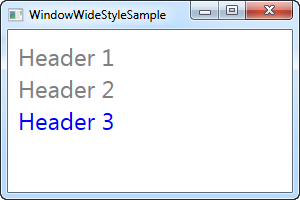
As you can see, the result is exactly the same, but it does mean that you could have controls placed everywhere within the window and the style would still apply.
Application-wide styles
If you want your styles to be used all over the application, across different windows, you can define it for the entire application. This is done in the App.xaml file that Visual Studio has likely created for you, and it's done just like in the window-wide example:
App.xaml
<Application x:Class="WpfTutorialSamples.App"
xmlns="http://schemas.microsoft.com/winfx/2006/xaml/presentation"
xmlns:x="http://schemas.microsoft.com/winfx/2006/xaml"
StartupUri="Styles/WindowWideStyleSample.xaml">
<Application.Resources>
<Style TargetType="TextBlock">
<Setter Property="Foreground" Value="Gray" />
<Setter Property="FontSize" Value="24" />
</Style>
</Application.Resources>
</Application>Window
<Window x:Class="WpfTutorialSamples.Styles.WindowWideStyleSample"
xmlns="http://schemas.microsoft.com/winfx/2006/xaml/presentation"
xmlns:x="http://schemas.microsoft.com/winfx/2006/xaml"
Title="ApplicationWideStyleSample" Height="200" Width="300">
<StackPanel Margin="10">
<TextBlock>Header 1</TextBlock>
<TextBlock>Header 2</TextBlock>
<TextBlock Foreground="Blue">Header 3</TextBlock>
</StackPanel>
</Window>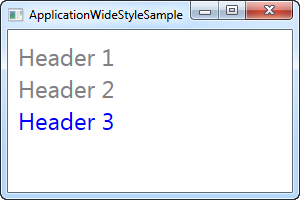
Explicitly using styles
You have a lot of control over how and where to apply styling to your controls, from local styles and right up to the application-wide styles, that can help you get a consistent look all over your application, but so far, all of our styles have targeted a specific control type, and then ALL of these controls have used it. This doesn't have to be the case though.
By setting the x:Key property on a style, you are telling WPF that you only want to use this style when you explicitly reference it on a specific control. Let's try an example where this is the case:
<Window x:Class="WpfTutorialSamples.Styles.ExplicitStyleSample"
xmlns="http://schemas.microsoft.com/winfx/2006/xaml/presentation"
xmlns:x="http://schemas.microsoft.com/winfx/2006/xaml"
Title="ExplicitStyleSample" Height="150" Width="300">
<Window.Resources>
<Style x:Key="HeaderStyle" TargetType="TextBlock">
<Setter Property="Foreground" Value="Gray" />
<Setter Property="FontSize" Value="24" />
</Style>
</Window.Resources>
<StackPanel Margin="10">
<TextBlock>Header 1</TextBlock>
<TextBlock Style="{StaticResource HeaderStyle}">Header 2</TextBlock>
<TextBlock>Header 3</TextBlock>
</StackPanel>
</Window>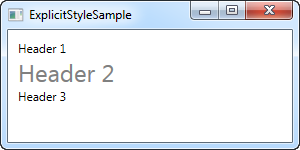
Notice how even though the TargetType is set to TextBlock, and the style is defined for the entire window, only the TextBlock in the middle, where I explicitly reference the HeaderStyle style, uses the style. This allows you to define styles that target a specific control type, but only use it in the places where you need it.
Summary
WPF styling allows you to easily re-use a certain look for your controls all over the application. Using the x:Key property, you can decide whether a style should be explicitly referenced to take effect, or if it should target all controls no matter what.